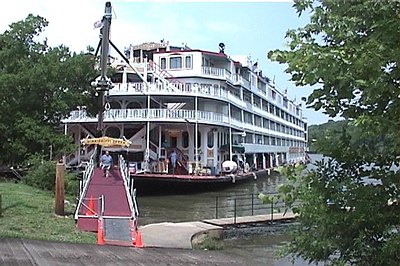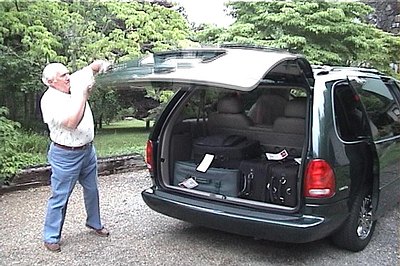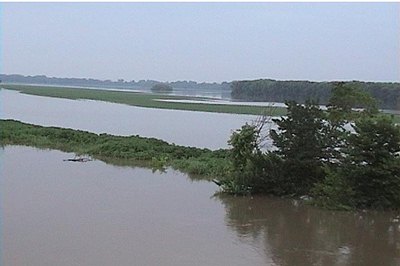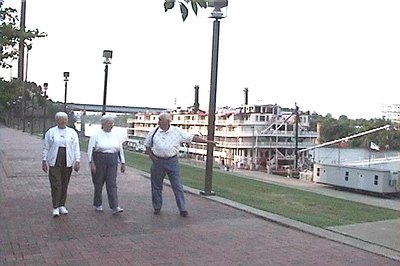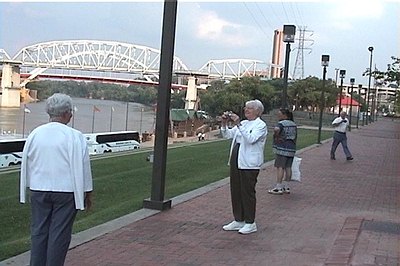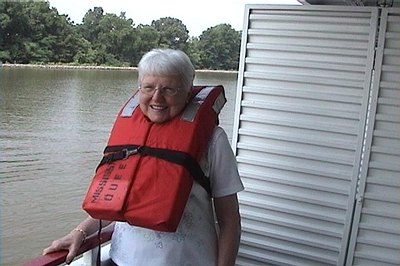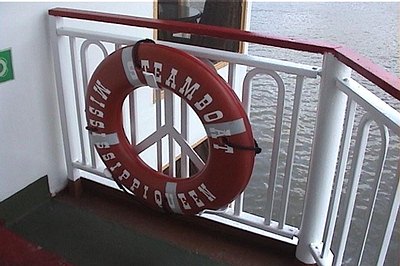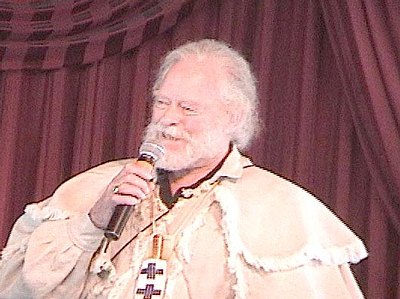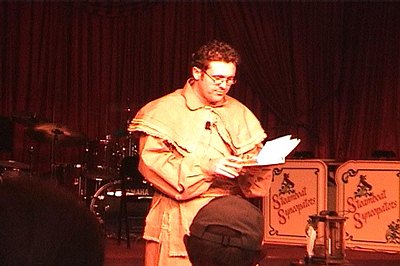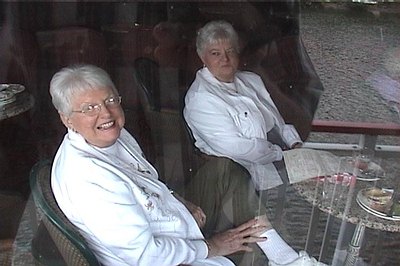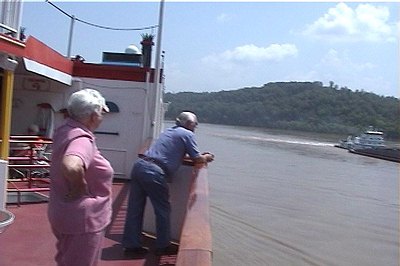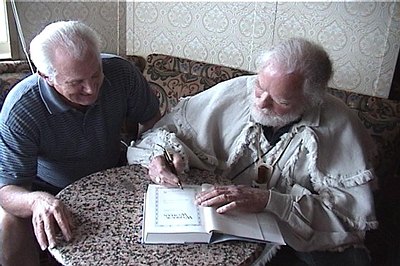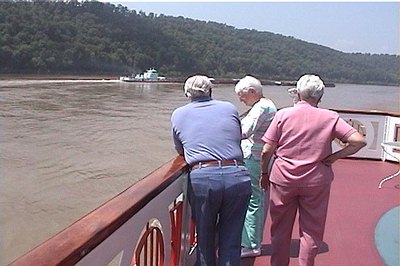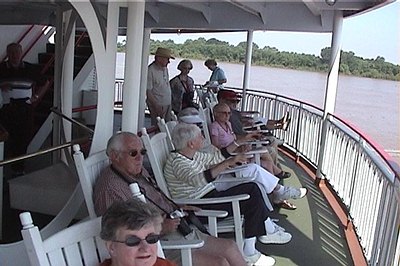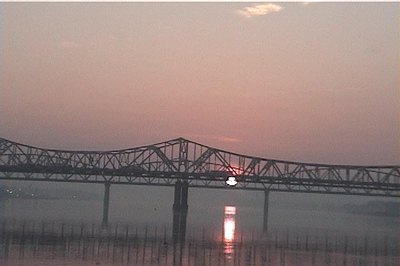Riverboat Cruise on the Mississippi Queen
June 4, 2004 to June 9, 2004
Ann's gift to the both of us for our 50th anniversary was a riverboat cruise on the historic Ohio River aboard the Mississippi Queen. Joined by friends Bob and Martha Davis, we studied maps, made plans for ground transportation to and fro, and looked forward to the trip which was to begin in Cincinnati, Ohio and end in Pittsburgh, Pennsylvania following the Ohio River upstream. Two days prior to departure, a call came from the travel agent, advising that due to heavy rains, the river was too high for the 59 foot tall riverboat (with the stacks lowered) to get under the bridges. Plans had to be hastily changed. The new route would begin in Nashville, Tennessee, going downstream on the Cumberland River to Paducah, Kentucky, then upstream on the Ohio to Louisville. We were not displeased with this change since it was much closer to Nashville than it would have been to Cincinnati.
Friday, June 4, 2004 - On this day of departure, we met the Davises at their home at 8:00am and began the trip to Nashville with Bob driving his minivan. Our first stop - the Country Cottage near Hayesville, North Carolina for breakfast. The trip to Nashville took about four hours, and with the one-hour time change, we were at dockside, boarding the riverboat by 1:00pm. A buffet lunch was being served. Bob found parking at the airport and caught a taxi back to town.
The change in schedule caused more problems for guests coming from the north. The steamship company chartered buses to bring folks from Cincinnati down to Nashville. Cast-off was delayed for two hours waiting for these buses to arrive. We killed time strolling along the Nashville waterfront, playing a few games of Joker, and eating again in the evening.
Finally, about 10:00pm the lines were hauled in, and we were underway. At first it was puzzling why the vessel headed upstream for several miles when we knew our destination was downstream. It soon became clear that we had to travel to a spot in the river where it was wide enough for the 382 foot long boat to turn around. Why weren't they headed downstream to start with? Sternwheelers always tie up with the bow pointed upstream to keep debris from being caught up in the paddlewheels. That maneuver took about an hour, so it was 11:00pm before we actually left Nashville. By then we were ready to turn in. Our outside staterooms were side by side on the port side of the boat, and we had adjoining balconies. The rooms were small, but adequate with two twin beds in each. We had a small bathroom and shower, a clothes closet, a table and chair, then two more chairs and a small table outside on the balcony.
Saturday, June 5th - At an average cruising speed of 7 mph, we were probably about 50 miles downstream on the Cumberland by 7:00am. The skies were clear, but there was nothing along the river to indicate where we were - just trees and lots of birds. From our 2nd level balconies we had a good view of things. The water was muddy with lots of trash floating around - tree limbs, pieces of styrofoam, old tires, plastic bottles, and more. The flood was flushing all kinds of stuff downstream.
The theme of this cruise was "The Native American," so there was a series of special folks who spoke on that subject. One of these was James Alexander Thom, author of many historical novels and the Indians of the midwest. He and his Shawnee wife, Dark Rain, were knowledgeable and well spoken. Mel Hankla, a history professor, did a dramatic presentation depicting the life of Simon Kenton, one of our pioneers. Kenton was a man revered by the Indians, and still is.
Each of the riverboats has a "riverlorian," a coined word merging "river" and "historian." Ours was Bill Wiemuth, who did an incredible job of bringing the history of the river to life. He was around the boat all during the day to answer questions about the river, the boat, navigation procedures, etc. He conducted a tour of the pilot house on this afternoon, talking about all the equipment used by the pilots to steer and control the boat.
The Mississippi Queen is powered completely by steam, generated by bunker C fuel. It is one of only six steam powered paddlewheelers still in operation in the country. There was a time back in the heyday of steamboats when there were 5,000 or 6,000 on the rivers. The boat is propelled by a paddlewheel on the stern which is 36 feet wide and 22 feet in diameter. Six hydraulicly controlled rudders are used for steering. There is a steam caliope on the stern that is played as the boat leaves each port of call.
Our first stop was at Dover, Tennessee - not sure why. There was an old fort there that some of the guests went to see. We stayed aboard and relaxed awhile. Shortly after leaving Dover, we gathered for our first formal dinner, sharing a table with a couple from Indiana and another from California. In addition to many preliminary dishes, we were served a two inch thick pork chop that no one was able to finish eating. Food aboard the Queen was good, but much too available. There was always a buffet open in the Grand Saloon, hot dogs and ice cream all day long on the caliope deck, plus three meals a day available in the dining room.
Entertainment each evening after dinner was excellent. A six-piece band accompanied a song and dance team that was good enough for Broadway - two men and two women. Not only were they good, but there was not one off-color joke, nor was there any profanity. They performed every night.
Sunday, June 6th - The boat arrived in Paducah, Kentucky during the night. The landing was so smooth, we were unaware that we were docked without looking out the window. An old car rally was in progress ashore. Paducah is protected from the river by a twelve foot high, twelve mile long flood wall that was built after a terrible flood in 1937 that competely inundated the town. Located at the confluence of the Tennessee and the Ohio rivers, Paducah is especially susceptible to flooding.
To get to Paducah, we had come down the Cumberland River, then cut across to the Tennessee on the Barkley Canal. We had then come down the Tennessee a few miles to the Ohio and tied up at Paducah on the Ohio River side - circling around to again point upstream.
The original town plat of Paducah was drawn up in 1827 by William Clark of Lewis & Clark fame. A notable feature of present-day Paducah is the artwork, still in progress, on the inside of the flood wall. We were tied up at the foot of Monroe Street, just a short distance from an opening in the wall and a short walk to the center of town. The artwork on the wall is unique. Each panel is being painted with a picture depicting some historical event in Paducah's past. The panels that have been completed are outstanding. We were told that the painting is being done at a cost of about $15,000 per panel, and there could be a hundred or more panels done before it is completed.
Some folks visited the famous quilt museum in Paducah; others went to the River Heritage museum; others strolled through the vendors at the old car rally who were selling all sorts of interesting things.
Back aboard the Queen, our riverlorian - Bill Wiemuth - spun an incredible tale, bringing alive the story of the first steamboat to travel all the way from Pittsburgh to New Orleans in 1811. That first steamboat, named "The New Orleans," was built by Nicholas Roosevelt who was aboard with his pregnant wife and two year old son on that first trip. The baby was born in Louisville while they were en route. The things they experienced would be incredible, even today. They encountered a floating island of squirrels - thousands of them trying to escape something. The sky was obliterated by a gigantic flock of pigeons - they too trying to get away from something. Then came a gigantic earthquake which caused the river to flow backwards for a spell. The wildlife may have had a premonition about the quake, or they may have been frightened by a giant meteor that was traversing the sky at the time. Then, the travelers had to outrun a band of attacking Indians and maneuver through a treacherous series of rapids. Despite all the obstacles, they made it, and that was the beginning of the steamboat era on the rivers. They had proven that it was possible to go down the river and back up again under power other than hand labor.
Today, the rivers are full of barges pushed along by big tugboats. One barge can carry the equivalent of about 58 truckloads of stuff - 15 tons. The barges are lashed together to form "tows." A "tow" consists of fifteen barges tied together and pushed by a tug. Literally thousands of these tows ply the rivers every day. One tow is the equivalent of 885 truckloads. We worry about all the semi trucks on our highways, but what would it be like if all this river traffic had to be shipped by truck.
At the next table to us at lunch were Jim Thom and Dark Rain, and we had the first of several opportunities to converse with them. He has authored Red Heart, Panther in the Sky, Follow the River, From Sea to Shining Sea, Children of First Man, Long Knife, and his latest book - Sign Talker. In addition to these, they have just recently co-authored Warrior Woman. It was such an interesting conversation that we had to buy a copy of Warrior Woman from the gift shop and have them autograph it.
Speaking of the gift shop, we learned that every guest had been given a $100 complimentary credit to spend aboard as we pleased - compensation for the inconveniences caused by the change in routing. That meant that each couple could get $200 worth of free stuff. It created a bonanza for the gift shop, and it was crowded throughout the trip. So, Warrior Woman was just the first of a number of purchases.
Monday, June 7th - The current of the Ohio cut deeply into the boat's speed. We had been cruising down the Cumberland at the speedy clip of 9 to 10 mph. Now, on the Ohio, that was cut to 5 mph. The riverlorian reported that the flood waters had crested at Cincinnati, and that we could expect the river to soon start dropping, though there was little sign of it. We were late arriving in Henderson, Kentucky because of all this, and the bridge there was critical. It was a railroad bridge with a water level guage that read 57 foot clear. With the stacks lowered, our height was 59 feet. If that guage was correct, we couldn't make it. The captain eased the boat right up to the bridge. Though it appeared that we would make it by a few inches, he backed off and tied up downstream to wait for the water to recede a bit.
That gave us a chance to go ashore in Henderson and explore the town a bit, though there wasn't much to see. Henderson was the home of John James Audubon, the famous bird artist. During his lifetime, he struggled to make ends meet because few people bought his paintings, but those same paintings have become priceless in the years that followed.
The river was full of floating logs and other debris. The boat kept out of the main channel to avoid the swiftest current, and inevitably hit those logs. The smaller ones gave only a mild thump, but larger logs gave the boat a real jolt. Fortunately, those jolts were few and far between, and somehow, the blades of the paddlewheel escaped damage. Otherwise the entire ride was smooth as glass.
Here's a bit of trivia provided by our riverlorian. One of the first steamboats to carry paying passengers was "The Washington," built by Henry Shreve. It had 20 cabins, each named for a different state. Thus the name - "staterooms." Shreveport, Louisiana was named for this man.
Leaving Henderson, with the receding water, we cleared the bridge by a couple of feet. It was a beautiful day. Homes along the river were still precariously close to the water. In many places, corn fields were still flooded. As the waters receded, much of the floating debris was deposited along the shore, providing a mark for how high the water had been.
During the afternoon, Bill Wiemuth presented the story of the Lewis and Clark Expedition through the eyes of the expedition's carpenter, Sergeant Cass. He dressed in a period costume and painted the picture in a dramatic way. It was, of course, impossible to tell the full story in a short hour, but he hit the high points. We came aboard thinking that the Thoms would be the main attraction. They were good, but Bill Wiemuth was clearly the star attraction. His presentations were outstanding. It was entertaining, and it was educational.
At dinner that night, the captain toasted the guests, and we were treated to champaign at the tables. Pictures were taken of everyone with the captain.
The Ohio River is the boundary between Kentucky and those states to the west. Through most of today's cruising, we had Kentucky on our right (starboard) side and Indiana on the left (port) side. The scenery was much the same - trees and more trees, with occasional signs of civilization. We saw five bald eagles on the journey and many other lesser species of birds, but no other wildlife.
Tuesday, June 8th - No stops this day. It was another nice sunny day, with the river obviously receding from its flood stage. Riverlorian Bill gave another presentation in the morning - this time it was the story of the Louisiana Purchase. He got a standing ovation for this one. Dark Rain then told of all the native foods and herbal health remedies the Indians use. Afterward, Bob and I had another opportunity to talk one-on-one with the Thoms. Surprisingly, he does all his writing on an old, 90 year old typewriter. They have a computer, but it is Dark Rain that is computer literate. He's currently working on a new book about the Mexican War. His favorite book is Panther in the Sky - the story of Tecumseh. It was during the research for this book that he met Dark Rain. We also had a conversation with Bill Wiemuth. He's been working for the company for seven years, as riverlorian for the last three. He works 30 days and is off 30 days. He's now working on a book of his own which he hopes to finish by Christmas. It's to be a novel built around the story of "The New Orleans" steamboat. He suggested sending him an email to get on the list for an early copy.
Continuing, there was very little change in the river scenery, though it was easy to see the high water mark where the foliage above the line was lush and green, while the foliage below the line was wilted. At this point the water had receded 12 to 15 feet. The trees were all hardwoods, though we were not close enough to the bank to identify them. It must be a pretty sight in the Fall. There were no stops on this day.
The boat pulled in to Louisville about 11:30pm after maneuvering through a huge lock system that raised us some 18 feet. This was the site of the Falls of the Ohio, that series of rapids that made the voyage of the early river travelers so exciting.
Wednesday, June 9th - We were up early (6:00am) this morning to get one last breakfast aboard before debarking in Louisville. The debarkation went smoothly. The company had chartered buses to get people to various points of departure from the city. Our immediate destination was the Louisville airport where we had a car rental reserved for the trip back to Nashville.
We got a quick tour of Louisville on the way to the airport, going by such places as the Louisville Slugger baseball bat factory, Churchill Downs, an old and beautiful residential section of town, the bus driver all the while describing things with a somewhat dry sense of humor.
The river cruise had taken five days and some 500 plus river miles to get from Nashville to Louisville. It took us only about three hours to cover the 170 road miles in our rented Ford Taurus along I-65. That makes it sound like a leisurely cruise, but the days were packed with such a large array of activities, that it was almost done at a frantic pace. The trip was educational and entertaining, and one we enjoyed very much, though it is always good to get back home to our mountain. The temperature when we left Nashville was in the mid-nineties. It was in the low seventies at Young Harris.
‘Til next time....
